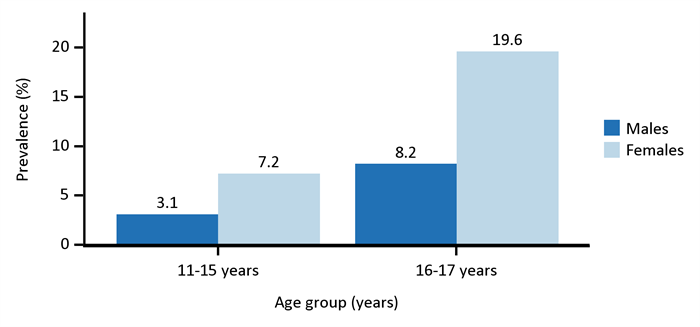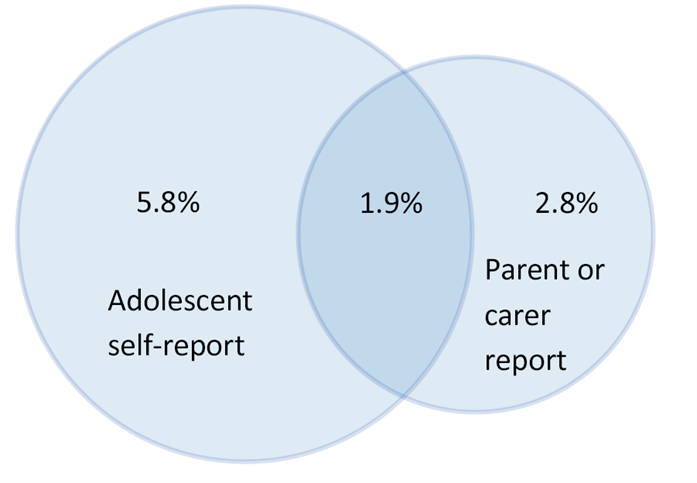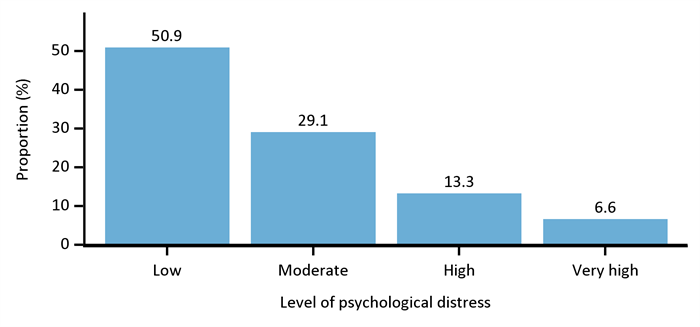What adolescents told us about their mental health
Young people aged 11 years and older were asked, with their parent's and carer's consent, to complete a questionnaire in private on a tablet computer - 89% did so. This included various measures of their mental health, as well as the same DISC-IV major depressive disorder diagnostic module completed by their parents and carers to assess if they had a major depressive disorder based on DSM-IV criteria.
Major depressive disorder based on adolescent self-report
-
- One in thirteen (7.7%) adolescents aged 11‑17 years met the DSM-IV diagnostic criteria for major depressive disorder in the previous 12 months.
- Major depressive disorder was more common in females and older adolescents, affecting 7.2% of males and 19.6% of females aged 16‑17 years.
Differences between youth reports and parent or carer reports of the same mental disorder
-
- The prevalence of major depressive disorder was far higher when young people provided the information themselves than when their parents and carers did so (7.7% compared with 4.7% of 11-17 year-olds).
- There was low agreement on the prevalence of major depressive disorder when comparing adolescent and parent or carer reported information (1.9%).
Psychological distress
-
- One fifth (19.9%) of adolescents had very high or high levels of psychological distress.
- This was almost twice as high for females (25.9% and 14.8% for males).
- This was four times higher (80.7%) for those with major depressive disorder based on self-report.
- One fifth (19.9%) of adolescents had very high or high levels of psychological distress.
What adolescents told us about behaviours that could put them at risk
Young people aged 11 years and older provided information on face-to-face and cyber bullying, problem eating behaviours and other behaviours that could put them at risk physically and/or mentally.
Bullying
-
- One third (34.3%) of 11-17 year-olds had been bullied in the previous 12 months. 11.3% felt a lot or extremely upset when bullied.
- Three fifths (62.8%) of young people with major depressive disorder based on self‑report had been bullied in the previous 12 months, and they were bullied more often.
- Three times as many (28.3% compared with 10.0% of all adolescents) were bullied every few weeks or more often.
- Two fifths (39.4%) felt a lot or extremely upset when bullied. - One in eight (12.7%) young people bullied someone else every few months or less and 2.0% did so every few weeks or more often in the previous 12 months. Young people with major depressive disorder were roughly twice as likely (22.5%) to bully someone else.
Problem eating behaviours
-
- Low weight problem eating behaviours (underweight on the age-adjusted BMI and practising weight controlling behaviours) were reported by 1.1% of 11-17 year-olds.
- Binge eating and purging were reported by 1.3% of 11-17 year-olds.
Smoking, alcohol and other substance use
-
- One in fourteen (7.2%) 13-17 year-olds had smoked in the last 30 days.
- Smoking was higher for young people with major depressive disorder, with one quarter (24.4%) having smoked in the last 30 days.
- Just over one in six (18.1%) young people had drunk alcohol in the last 30 days and 12.5% had drunk more than four drinks in a row in the last 30 days.
- Alcohol consumption was higher among young people with major depressive disorder based on self-report, with 27.6% having drunk more than four drinks in a row in the last 30 days.
- One in twenty (5.0%) young people had used cannabis and 1.6% had used other drugs in the last 30 days.
- Use was far higher for young people with major depressive disorder based on self‑report, with 13.1% having used cannabis and 6.1% other drugs in the last 30 days.
Internet use and electronic gaming
-
- One quarter (24.9%) of 11-17 year-olds spent 3-4 hours a day on weekdays on the internet, while 17.6% spent 5-8 hours and 10.3% spent 9 hours or more. Use was similar on the weekend (25.9%, 23.7% and 12.1%).
- One eighth (12.2%) of 11-17 year-olds spent 3-4 hours a day on weekdays playing electronic games, while 6.9% spent 5-8 hours and 2.5% spent 9 hours or more. Use almost doubled on the weekend (19.7%, 12.3% and 4.7%).
- Internet use and/or electronic gaming were highly problematic for 3.9% of 11-17 year‑olds, affecting their ability to eat, sleep, and spend time with family, friends and doing homework.
Prevalence of major depressive disorder in the past 12 months based on self-reports in 11-17 year-olds

Prevalence of major depressive disorder in the past 12 months in 11-17 year-olds based on self-report and/or parent/carer reports

Psychological distress levels in 11-17 year-olds
